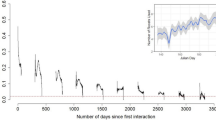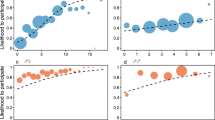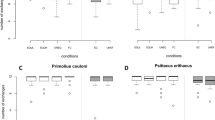Abstract
Behavioural reciprocity can be evolutionarily stable1–3. Initial increase in frequency depends, however, on reciprocal altruists interacting predominantly with other reciprocal altruists either by associating within kin groups or by having sufficient memory to recognize and not aid nonreciprocators. Theory thus suggests that reciprocity should evolve more easily among animals which live in kin groups. Data are available separating reciprocity from nepotism only for unrelated nonhuman animals4. Here, I show that food sharing by regurgitation of blood among wild vampire bats (Desmodus rotundus) depends equally and independently on degree of relatedness and an index of opportunity for recipro cation. That reciprocity operates within groups containing both kin and nonkin is supported further with data on the availability of blood-sharing occasions, estimates of the economics of shar ing blood, and experiments which show that unrelated bats will reciprocally exchange blood in captivity.
This is a preview of subscription content, access via your institution
Access options
Subscribe to this journal
Receive 51 print issues and online access
$199.00 per year
only $3.90 per issue
Buy this article
- Purchase on Springer Link
- Instant access to full article PDF
Prices may be subject to local taxes which are calculated during checkout
Similar content being viewed by others
References
Axelrod, R. & Hamilton, W. D. Science 211, 1390–1396 (1981).
Boorman, S. A. & Levitt, P. R. The Genetics of Altruism (Academic, New York, 1980).
Brown, J. S., Sanderson, M. J. & Michod, R. E. J. theor. Biol. 99, 319–339 (1982).
Packer, C. Nature 265, 441–443 (1977).
Wright, S. Evolution and the Genetics of Populations Vol. 1 (University of Chicago Press, 1968).
Altmann, J. Behaviour 49, 227–267 (1974).
Fager, E. W. Ecology 38, 586–595 (1957).
McFadden, D. Frontiers in Econometrics (ed. Zarembka, P.) 105–142 (Academic, New York, 1974).
Truett, J., Cornfield, J. & Kannel, W. J. chronic Dis. 20, 511–524 (1967).
Lord, R. D., Muradali, F. & Lazaro, L. J. Mammal. 57, 573–575 (1976).
McNab, B. K. J. Mammal. 54, 131–144 (1973).
McFarland, W. N. & Wimsatt, W. A. Comp. Biochem. Physiol. A28, 985–1006 (1969).
Morton, D. & Richards, J. F. Comp. Biochem. Physiol. A69, 511–515 (1981).
Ligon, J. D. Am. Nat. 121, 366–384 (1983).
Connor, R. C. & Norris, K. S. Am. Nat. 119, 358–374 (1982).
Jarvis, J. U. M. Bull. Carnegie Mus. nat. Hist. 6, 81–87 (1978).
Teleki, G. The Predatory Behavior of Wild Chimpanzees (Bucknell University Press, Lewisburg, 1973).
MacDonald, D. W. & Moehlman, P. D. Perspectives in Ethology Vol. 5 (eds Bateson, P. P. G. & Klopfer, P. H.) 433–467 (Plenum, New York, 1982).
Malcolm, J. R. & Marten, K. Behavl Ecol. Sociobiol. 10, 1–13 (1982).
Engelman, L. BMDP Statistical Software (eds Dixon, M. B. et al.) 330–344 (University of California Press, Berkeley, 1981).
Author information
Authors and Affiliations
Rights and permissions
About this article
Cite this article
Wilkinson, G. Reciprocal food sharing in the vampire bat. Nature 308, 181–184 (1984). https://doi.org/10.1038/308181a0
Received:
Accepted:
Issue Date:
DOI: https://doi.org/10.1038/308181a0
This article is cited by
-
Co-roosting relationships are consistent across years in a bat maternity group
Scientific Reports (2024)
-
Basic Evaluation Process and some Associated Phenomena, Such as Emotions and Reactive Defense of Beliefs
Integrative Psychological and Behavioral Science (2023)
-
Family first! Influence of parental investment in Guinea pigs (Cavia porcellus) prosocial choices
Animal Cognition (2023)
-
Social norms and superorganisms
Biology & Philosophy (2023)
-
Men increase time spent on a charitable task when in the presence of women and other men: Evidence of competitive altruism in online mating scenarios
Current Psychology (2023)
Comments
By submitting a comment you agree to abide by our Terms and Community Guidelines. If you find something abusive or that does not comply with our terms or guidelines please flag it as inappropriate.



